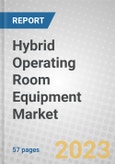For market estimates, data has been provided for 2022 as the base year, with forecasts for 2023 through 2028. Estimated values are based on revenue from HOR equipment companies. Projected and forecasted revenue values are in constant U.S. dollars that have not been adjusted for inflation.
Report Includes
- An overview of the current and future global market for hybrid operating room equipment
- Analyses of the market trends, with historical market revenue data (sales figures) for 2022, estimates for 2023, forecasts for 2024 and 2026, and projections of compound annual growth rates (CAGRs) through 2028
- Estimates of the market size and revenue forecasts for the market in USD millions, and a corresponding analysis of market share based on component, application, end user and region
- Discussion of the major factors influencing the growth of this market with respect to opportunities and challenges, emerging technologies, future prospects and contributions to the overall market
- Insight into the importance of ESG in the market, including consumer attitudes, impact of ESG factors on corporate performance and the ESG practices of leading companies
- Identification of the major stakeholders and analysis of the competitive landscape based on recent developments, key financials and segmental revenues, and operational integration
- Profiles of the leading players in the market
Table of Contents
Executive Summary
A hybrid operating room is adopted mainly for complex cardiovascular, neurological, orthopedic, and other surgeries. Rapid technological development and demand for open and minimally invasive surgeries are the key factors driving the growth of the global hybrid operating room market. The increasing number of surgical application areas will also inject growth within the market. Surgical oncology and aesthetic surgery are key applications that will increase the adoption of HORs during the forecast period.Further, companies are looking to develop advanced technology to maintain their position within the global market. For instance, in November 2022, Philips introduced an artificial intelligence (AI)-powered platform to enhance diagnostics from imaging scans. The platform, accessible via Philips’ IntelliSpace Portal, connects cardiology, oncology, neurology, and radiology departments, simplifying data sharing and communication for improved diagnoses. Further, in June 2022, Promaxo Inc. launched an in-office MRI system—a single-sided MRI integrated with an AI-based imaging system—at East Valley Urology Centre. All such development initiatives by companies to enhance imaging systems boost growth in the HOR equipment market.
North America holds the largest revenue share in HOR equipment. This is attributed to many North American companies operating in the HOR equipment space, and the rising mortality concern in the region due to cardiovascular disease. In the U.S., in 2021, around 650,000 people died due to heart disease, accounting for one in five deaths, according to the National Center for Chronic Disease Prevention and Health Promotion.








